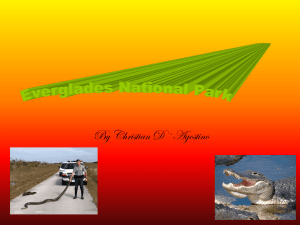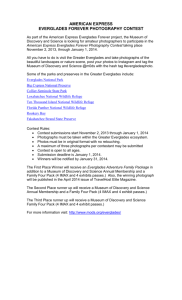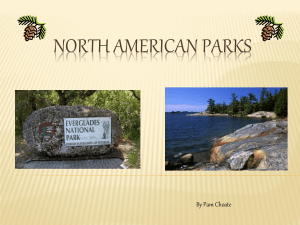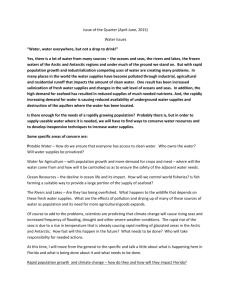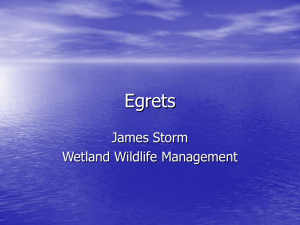TEN THOUSAND ISLANDS BOAT TOUR - EvergladesTRT
advertisement
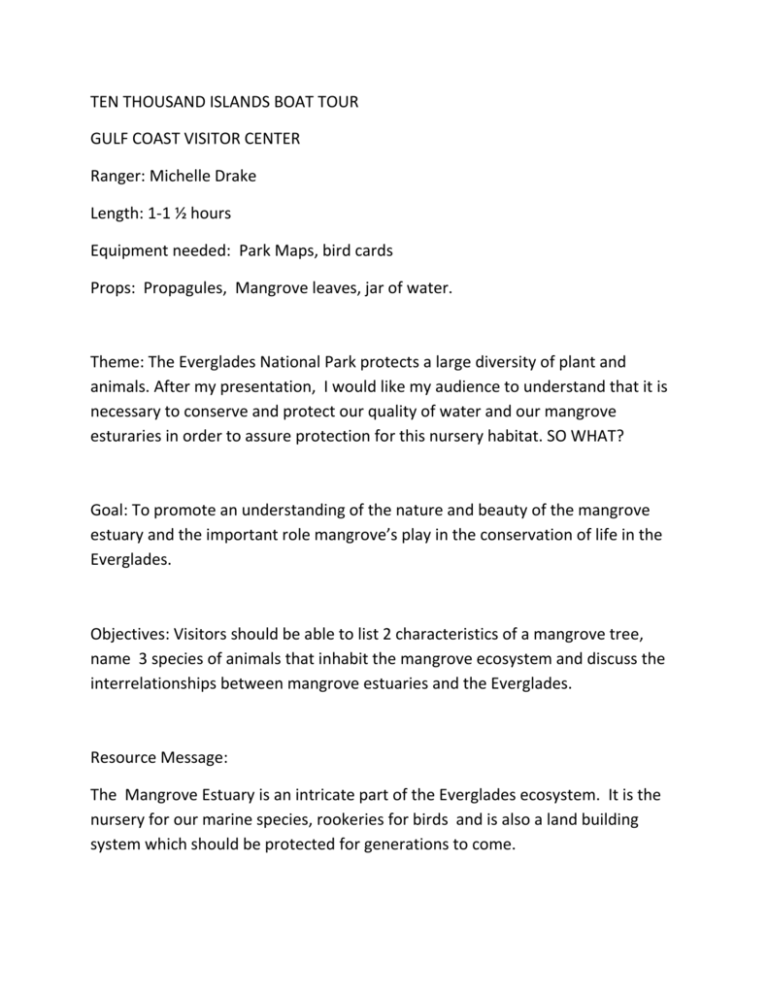
TEN THOUSAND ISLANDS BOAT TOUR GULF COAST VISITOR CENTER Ranger: Michelle Drake Length: 1-1 ½ hours Equipment needed: Park Maps, bird cards Props: Propagules, Mangrove leaves, jar of water. Theme: The Everglades National Park protects a large diversity of plant and animals. After my presentation, I would like my audience to understand that it is necessary to conserve and protect our quality of water and our mangrove esturaries in order to assure protection for this nursery habitat. SO WHAT? Goal: To promote an understanding of the nature and beauty of the mangrove estuary and the important role mangrove’s play in the conservation of life in the Everglades. Objectives: Visitors should be able to list 2 characteristics of a mangrove tree, name 3 species of animals that inhabit the mangrove ecosystem and discuss the interrelationships between mangrove estuaries and the Everglades. Resource Message: The Mangrove Estuary is an intricate part of the Everglades ecosystem. It is the nursery for our marine species, rookeries for birds and is also a land building system which should be protected for generations to come. PROGRAM OUTLINE: Welcome to the Everglades!!! Ice Breaker: Introductions (captain, mate and me), names, where from, first trip to ENP?, other NP’s? Point out other 3 parks in south Florida, Biscayne, Dry Tortugas, and Big Cypress. Big Idea 1. Historical Water Flow of Everglades 2. KOE water shed; from Kissimee, through Okachobee Lake, to Everglades Map? 2. Limestone - porus rock made of calcium carbinate, aquifers – underground storage areas of fresh water stored in the limestone, our fresh water source for so. Florida Big Idea 2. Human History 2. Native People – 10,000 BC – 8,000 BC, Paleo-Indian, arid conditions, lived with mammoths, began to adapt to wetlands, patterns, became hunters. 8,000 BC – 750 BC after glacial p. sea level rose 5,000 BC cypress swamps and hardwood forests, subtropical climate terrain, using shelfish and marine resources, use of tools and pottery 750 BC – 1500 AD characterized by pottery types, thriving trade network, resources (lithic tools and ornaments) Historic Contact – 1500 – 1700 Europeans – 5 tribes, Calusa dominate other tribes – 20,000, by 1763 reduced to several 100; demise of indigenous people – Creek peoples move in, Seminoles early as 1800, Seminole wars, bands moved further into the Everglades to avoid removal (midens – shell mounds) Big Idea 3. Mangrove Estuaries 2. def. estuary ( area where salt and fresh water come together usually at the end of a river where it reaches the sea) 2. 3 types of mangroves – from waters edge to inland 3. Red –ariel prop roots, 2 functions (roots support tree and used for breathing), nurseries since in and out of water due to tides 3. Black – in soil, “pencils” grow upward above the soil Black bark 3. white – more inland, leaves round, leaf has two glands called nectarines that excrete sugar 3. tannin in leaves causes discoloration of the water 2. Second largest mangrove area in world, important because: 3. protect and reduce erosion of shorelines 3. create habitats for fish, shrimp, crabs,sharks, etc. (nursery) 3. leaf litter which benefits food chains 3. barrier from storms 3. land building Big Idea 4. Inhabitants 2. Plants 3. mangroves & buttonwood 2. Animals 3. Birds 4. Pelicans 4. Osprey 4. Snowy Egret 4. Cormorant 4. Great Blue Heron 4. Little Blue Heron 4. Tri-colored Heron 4. Great Egret 4. Frigate 3. Turtles 4. Loggerhead 4. Green Sea Turtle 4. Hawksbill 4. Kemps Ridley 3. marine mammals 4. atlantic bottlenose dolphin 4. manatee Big Idea 5. History of Water Management 2.Canals & Flood Control 3. draining “swamp” for farm land 3. land encouraged developers , trains, new cities, etc. 3. more canals and roads 3. 1948 Central & South Florida Project – Army Corp of Engineers; provide for water, flood protection, water supply, for Everglades, preserve fish & wildlife habitat, facilitate navigation and recreation, and prevent salt water intrusion 3. increasing population and changes in land use – degraded the natural system of the KOE watershed and the Everglades. 2. Problems for the Everglades 3. 50% of Wetlands gone 3. Loss of habitat for animals – endangered & threatened 3. wading birds reduce by 90% 3. intrusion of exotic plants and animals – Burmese python 3. die off of sea grasses 2. Everglades Restoration – 3. CERP – Comprehensive Everglades Restoration Plan – 10.5 billion, take 30 years, “restore the right quanity, quality, timing, and distribution” of fresh water to the natural system. 4. remove levees and canals 4. reduce loss of water from eastern side of park 4. improve spatial distribution of water 4. restore overland flow to help with the high salinity in Florida and Biscayne Bays CONCLUSION: 1. Thank you for coming 2. Stress importance of this unique environment 3. Captain – docking procedures. Brown Pelican Most common, may spot white which are rare, gifts to attract a mate, live in large flocks know as rookeries, eat the 4lbs fish a day, hunt for food by diving into the air and then plunging 60 ft. in water, can hold 3 gals of water, bottom of bill, also use as air conditioner, 61/2 – 7 ½ wingspan, 2-3 feet tall. White are taller. Osprey Food – fish, male chest white, Female dark necklace streaks around neck,builds nest on man-made structures, takes 5 days for all chicks to hatch, older chick dominate, younger chicks can starve, barbed pads on talons to help grip fish, carries fish headfirst to nest to make it aerodynamic. Snowy Egret Snowy Egret Small, lacy white plumage, black legs, yellow feet, Different from Great Egret Cormorant Goose-long neck, webbed feet, hooked bill, propel through water with web feet, produce pellets like owls. Diving bird Great Blue Heron Largest and heaviest birds in Ever (5lbs), most vocal Wading bird, food fish *Little Blue Heron same except smaller *Tri-colored Heron Great Egret 2lbs., black legs and feet Frigate Bird Size of Osprey, forked tail, when flying looks like Batman symbol, “man of war” bird because it Steals other birds food Roseate Spoonbill 28”-32” tall, greenish head, spoon-shaped bill, White neck, pink body, orange tail Anhinga 33-35”, black body, long neck, Yellowish bill, silvery streaking, Long tail, straight beak
